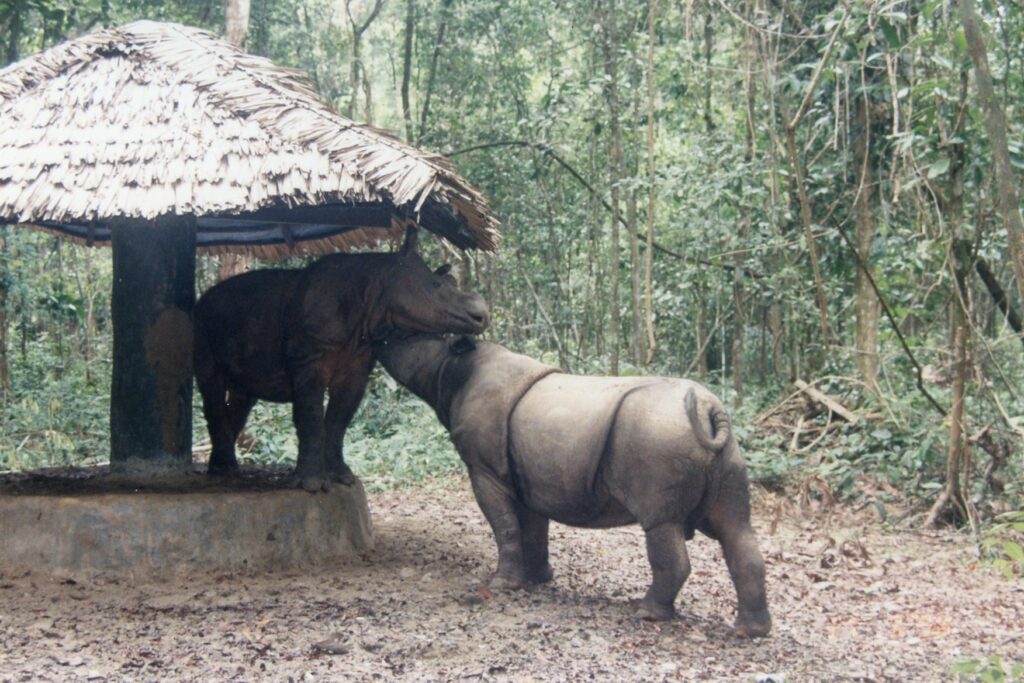Lessons Learned From Sumatran Rhino Conservation Breeding

By Kees Rookmaaker
Rhino Resource Center
Rookmaaker, L.C., 2019. The history of the captive breeding programs of the Sumatran Rhinoceros 1984-2019. Report commissioned by the International Rhino Foundation, pp. 1-105
This report is a survey of the literature written about the Sumatran rhinoceros (Dicerorhinus sumatrensis) captured in Malaysia (Peninsula, Sabah) and Indonesia (Sumatra, Borneo) from the middle of the 1980s. Literature has been interpreted in a wide sense to include not only writings in scientific and popular books and journals, but also to some extent unpublished reports, newspaper columns, internet blogs and websites. This reflects the holdings of the Rhino Resource Center, arguably the most comprehensive and complete library of everything written about every species of rhinoceros.

Summary of Findings
The American Association of Zoos and Aquariums (AZA) started to develop Species Survival Plans in the early 1980s which included all species of rhinoceros. The concept of captive breeding was then discussed with the IUCN and the incumbent Asian Rhino Specialist Group.
A conference was organized to discuss the possibilities for the Sumatran Rhino, held in Singapore in October 1984. This led to a set of recommendations known as the Singapore Proposals which included a captive breeding program for the preservation of the genetic diversity.
While the AZA had hoped to start with captures in Sabah and possibly Peninsula Malaysia, this became the focus of political debate resulting in an export ban. Malaysia started its own program, which would include a total of 14 Sumatran rhinos (4 males, 10 females) 1984-1994. The animals were kept in Melaka Zoo and a breeding facility in Sungei Dusun. In 2003 the remaining rhinos died from disease cased by bacterial infection.
The first rhinos captured in Indonesia were part of a Memourandum of Understanding signed with John Aspinall of Port Howlett, United Kingdom. In total 8 animals (4 males, 4 females) were captured under this program, divided among Port Howlett and three facilities in Indonesia.
The American zoos then shifted attention to Indonesia where rhinos were captured under an agreement with the Indonesian Government from 1988. A total of 10 rhinos (3 males 7 females) were captured, of which 7 were exported to the U.S.A. to be kept in Los Angeles, New York, San Diego and Cincinnati. There were 3 births in Cincinnati (2001, 2004, 2007).
The Cincinnati Zoo was proactive in research of the reproductive difficulties of the Sumatran rhinos. One pair gave birth to 3 babies (2 males, 1 female) in 2001, 2004 and 2007. Two of these animals were moved to the SRS Way Kambas.
Sabah (East Malaysia) started its own national rhino program, which would involve 13 rhinos (9 males, 4 females) captured 1987-2014.
In Kalimantan, Indonesian Borneo, 2 female rhinos have been captured in 2016-2018, of which one survives.
When it became clear in the early 1990s that captive breeding encountered multiple challenges especially in facilities outside the range states, discussions started which led to the establishment of a Sumatran Rhino Sanctuary (SRS) located within the borders of Way Kambas National Park, Sumatra, Indonesia, inaugurated in 1998. A second phase of the SRS with much extended facilities was opened in October 2019.
The Sumatran Rhino Sanctuary in Way Kambas has been home to 3 rhinos transferred from other zoos in 1998, 2 females captured in Sumatra in 2005, and 2 young rhinos moved from Cincinnati. One pair has produced 2 babies (1 male, 1 female) in 2012 and 2016.
The first phase of the rhino capture program started in 1984 and continued up to 1995 has not been an unmitigated success. There has been criticism from many quarters. A total of 47 rhinos were captured, and these have had just six offspring. This was not because the proposals of 1984 were wrong, rather the Sumatran rhino proved to provide challenges in husbandry and reproduction which could not have been foreseen. Many animals had or developed pathologies in the reproductive tract. Behavior and diet differed from other rhino species.

This survey of literature has shown that there were a number of areas where we are learning lessons from the past.
The following recommendations can be formulated in response to these past challenges.
1. All subspecies of the Sumatran rhino can be mixed to achieve maximum breeding success.
2. All Sumatran Rhinos captured in Sumatra, Malaysia, Sabah, Kalimantan must be managed as one meta-population. Political boundaries must be disregarded for purposes of conservation.
3. A balanced diet of browse is of crucial importance in the well-being of the rhinoceros in captivity.
4. Enclosures must be hygienic and provide shade and wallows.
5. Enclosures must be large enough to allow space during fights between animals.
6. The design of enclosures must allow for solitary periods of the rhinos.
7. The presence of qualified veterinarian staff with proper equipment on a continuous basis can ensure the health of the animals.
8. New animals should be sourced from viable large populations with known breeding females.
9. Artificial Reproductive Techniques must be used to maximize the genetic material of all Sumatran Rhinos in the captive breeding program.
You can access the full research report at http://www.rhinoresourcecenter.com/index.php?s=1&act=refs&CODE=ref_detail&id=1634651290
